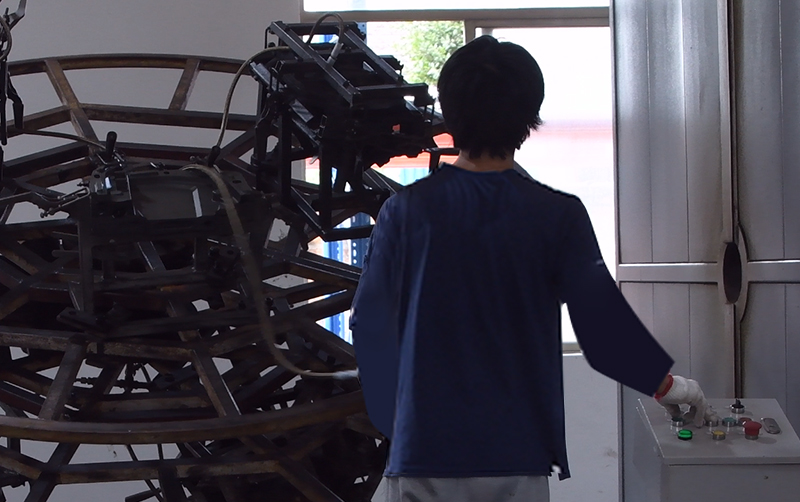What are the common problems in rotational molding process?
 Feb 28,2022
Feb 28,2022

What are the common problems in rotational molding process?
As versatile as it is, rotational molding process is not completely problem-free. Problems occur due to the various factors such as resin, rotomoulder, molds, processes, product structure, etc.
Below are the guidelines of troubleshooting to common problems in rotational molding process.
Bubbles on the surface or parting line
Bubbles occur in the rotational molding process due to the factors such as inadequate venting, incompatible mold release, moisture of the resin. The suggested actions are:
- Relocate the vent to the middle of the mold and increase the vent size
- Change mold release
- Dry the resin
Blow hole through part
- Porosity in cast aluminum mold- Use better mold release
- Drill through void and drive in pin or weld from outside
- Relieve from outside by drilling into void from side
- Remove parts from molds while mold is quite warm to touch, which helps drive moisture out of pores.
Uneven wall thickness
Uneven wall thickness is cause in the rotational process by the factors such as improper mold speed and rotation ratio, uneven mold surface temperature, mold shielded, mold arm improperly balanced, fast fusion rate, inadequate powder properties etc.
- Change ration and speed of the rotation mold to obtain even coverage and adequate number of powder
- Check for shielded areas, mount mold to eliminate shielding
- Increase heat time and lower mold temperature
- Use compatible powder
Discoloration
- Resin degradation- Decrease oven temperature or heating cycle. Increase or change antioxidant. Change to more thermally stable pigment.
- Oxidation on mold surface- Clean mold surface and check the source of moisture.
- Excessively long cycle- Reduce oven heat temperature, or decrease the heating cycle.
Low impact strength
- Improperly sintered-increase or decrease oven temperature and heating cycle.
- Improper coloring- Select pigment and pigment loading that does not affect impact. Use pre-colored compounds
- Over-cured resin- Decrease oven temperature or time
- Insufficient fusion of resin- Increase temperature or heat time
- Inappropriate design- Revise product design
- Improperly cooled-change cooling cycle rate
- Insufficient fusion of resin
Low stiffness
- Part wall is too thin - Add more powder to the initial charge
- Resin is incorrect - Use resin of higher density
- Product design is not appropriate- Review and modify the mold design if necessary
- Resin is under fused- Increase oven temperature or total heating cycle.
- Increase heat-transfer rate by using thinner mold walls, or make mold from material with greater heattransfer coefficient, for example, steel, aluminum, copper
Warping,shrinkage, deforming
- Inadequate venting- Increase vent size.
- Unevenly cooling - Rotate mold during cooling cycle.
- Use less release agent - Reduce cooling rate during initial part of cooling cycle. Change air pressure inside part during cooling. Increase cooling medium temperature.
- Uneven mold wall thickness - Re-design mold.
- Parts of mold are shielded - Change how mold is mounted to arm. Add baffles to direct heat to recessed or shielded areas.
- Part is overcured - Decrease oven temperature or the heat cycle.
- Powder gets moisture - Dry powder or change the drying procedure.
Long oven cycles
- Heat transfer rate is inadequate to melt all the resin, mold is excessively thick - Reduce mold wall thickness or change mold material.
- Heating is not efficient- Increase air velocity, check oven for leaks
- Low oven temperature- Check oven temperature sensor and re-calibrate or replace
- Resin powder too coarse -Use finer mesh powder.
Unable demolding
- Insufficient mold release - Use mold release more often and/or change applicable method.
- Ineffective release agent - Change type of release agent.
- Rough mold surface - Refinish mold surface.
- Build-up of degraded resin on mold surface - Clean mold surface periodically.
- Material is too stiff to release from mold undercuts - Change material or reduce undercuts.
- Material shrinkage - User higher density resin.
Products have flash
- Clamp pressure is insufficient - Increase clamp pressure or type of clamp used
- Internal mold pressure is incorrect during heating cycle - Check the vent clogging. Reduce the air pressure. Relocate the vent. Increase vent size.
Besides the problems mentioned above, there are many potential failure modes in the rotational molding process, which affects the functionality and aesthetics, or lead to defective products. It is of vital importance to take all the factors into considerations to catch the potential problems in the rotational molding process.
As a custom rotomolding factory, the engineering and production team have rich experience in rotational molding process, product design, development and testing. Always in pursuit of perfection, we keep an close eye on every step in the production and strive to make continuous improvement by following lean manufacturing principles and minimizing waste in the workplace, which transfers into the benefits of cost savings and improved lead times for customers. Those competitive advantages make Light Venus a reliable rotational molding partner for original equipment manufacturers worldwide

 Tel: 0086-13632687993
Tel: 0086-13632687993  Email: roto@lightvenus.com
Email: roto@lightvenus.com

 Home
Home How to decide whether rotomolding is the right process for a plastic product?
How to decide whether rotomolding is the right process for a plastic product?  You May Also Like
You May Also Like



 Tel
Tel
 Email
Email
 Address
Address








